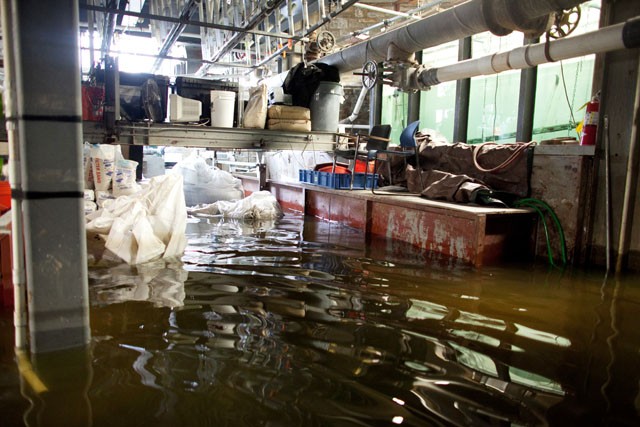The water in the basement rose daily, and graduate student Antoinette Abeyta continued her research âÄî until the water reached just below the top of her rubber boots.
Abeyta and her fellow St. Anthony Falls Laboratory researchers reluctantly evacuated the basement last week for the annual spring flooding that brings in 2 to 3 feet of Mississippi River water.
In a facility built on top of St. Anthony Falls to conduct hydraulic research, the flooding is pretty common. River water flows through a channel under the basementâÄôs concrete floor and surfaces through large holes.
Preparation began weeks ago when SAFL employees started monitoring weather websites to predict the floodâÄôs timing and intensity. They knew recent rain, heavy snowfall and a late spring would lead to a fast melt.
When water rushing over the falls neared 30,000 cubic feet-per-second âÄî the Federal Energy Regulatory CommissionâÄôs definition of flooding âÄî a crew of employees descended into the buildingâÄôs lowest level and lifted buckets, tools, chairs, experiments and equipment 3 feet off the ground wherever it would fit.
When the water finishes draining, theyâÄôll take garden hoses and spray everything down.
âÄúThereâÄôs a reason they call it Mississippi mud,âÄù researcher Ben Erickson said.
Erickson, his SAFL colleagues and interested outsiders go down every day to look at the waterâÄôs progress.
âÄúItâÄôs a curiosity,âÄù he said.
A week ago, as the flood was starting, Erickson took a late-night drive to check on the lab âÄî and found other researchers doing the same.
âÄúNobody could sleep real well,âÄù he said. âÄúYou worry.âÄù
The SAFL building has two large channels running its length. During flood season, the amount of water rushing through the tunnels daily equals what cascades over the falls in 30 seconds, SAFL engineer Craig Hill said.
Until the water recedes back to shin level, Abeyta is continuing to process data for her project elsewhere. Funded by large oil companies, sheâÄôs studying how landslides start in the deep ocean.
Abeyta feeds sand and crushed walnuts into a large water-filled tank to form sticky sediment that mimics a delta. Then she records what happens during a six-hour run.
Each video is broken into one-second frames that she must click through to find the exact initiation of particle motion. ThatâÄôs how sheâÄôs spending her three weeks of being displaced.
âÄúItâÄôs a little cold to work in the water,âÄù she said.
Another basement project involves testing a storm water filter with trash to perfect it for Minnesota Department of Transportation use. For now, itâÄôs on hold.
Between 80 and 100 SAFL projects continue to operate normally during the flood stage because theyâÄôre above the flood zone.
Floodwaters crested April 12, and within the week, Erickson said âÄúour basement will be back in business.âÄù
âÄúFrom the river it came, and back to the river it goes.âÄù

Basement flooding at the St. Anthony Falls Laboratory is expected to peak at 3 feet.
Annual river flooding leaves some research high and dry
Some projects at the St. Anthony Falls Laboratory are on hold.
Published April 18, 2011
0
More to Discover







